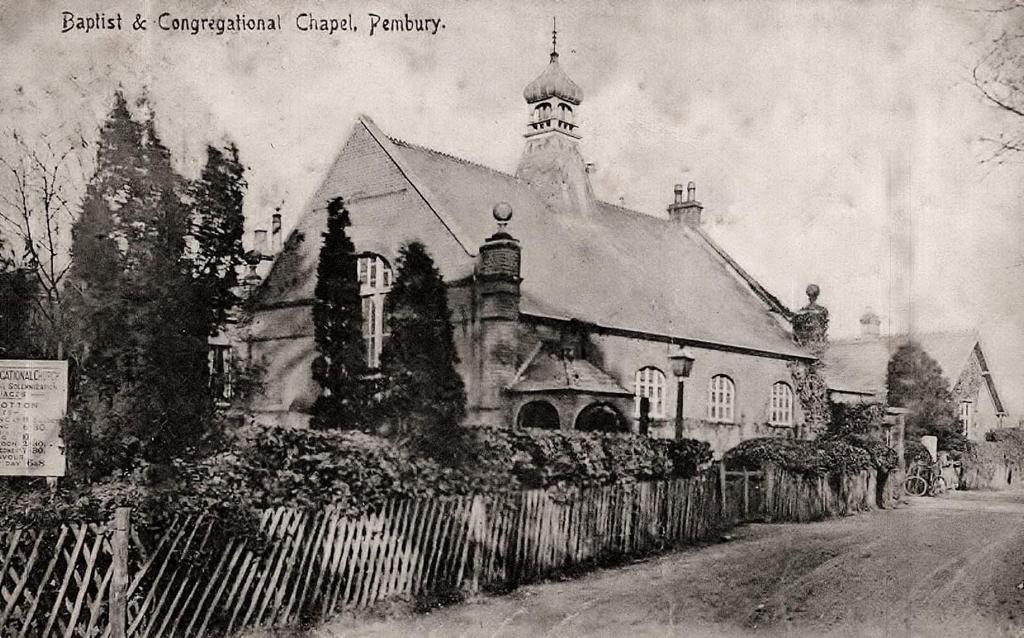
From 1835 to Present Day
'The life of this fellowship was given birth by the Holy Spirit; it is the Holy Spirit that has maintained its life, and it is the Holy Spirit that is going to continue and advance the work of Christ's Kingdom in these last days. Glory to God.' Rev. Gerald Pimentel, Pastor of Pembury Baptist Church from 1983 to 1991.
Stephen Dickenson lived in a farmhouse, since demolished, in the Stone Court area of Pembury and as a young man worshipped at the Countess of Huntingdon's Chapel in Tunbridge Wells. He had been encouraged to go - even walk there and back each week - by a godly miller who worked on the Hawkwell estate. His brother Daniel was 20 years old before he was persuaded to go to chapel in 1786.
Daniel took over the tenancy of Downingbury Farm. He and his wife were both committed to the Chapel in Tunbridge Wells, but by 1834 they decided to there was a need for a chapel in Pembury. Perhaps the congregation meeting at "The Cottage" (Stephen's house in Lower Green), had grown too large.
They were able to obtain £225 from the sale of a disused chapel in Penshurst. With this, building began and the first chapel was completed in 1835 at a total cost of £458. A trust was set up - still existing today. Around that time the population in Pembury was probably still under 1000. In the first few years of the chapel's life, services were taken by members of the Countess of Huntingdon's chapel in Tunbridge Wells. Mr George Cooke became the first settled pastor from 1841 to 1847.
In 1846 a manse was built for £467 on ground given by Benjamin Veness, by then a deacon and trustee.
In 1862 Elizabeth Dickinson, the last of the Dickensons died. Daniel and his wife had no children, Stephen and his wife had 3 daughters. The grandchildren of Stephen erected a memorial tablet that we see today erected on the wall of the church.
It is said that Elizabeth Dickenson's earnest prayers before her death were that others should come to Pembury to carry on the work started by the Dickenson family.
This prayer was answered when John and Maria Betts came to Pembury in 1863. They were so distressed at the inability of local people to read and write that they persuaded others to join them in providing finance for a school. Benjamin Veness again gave the land adjoining the chapel and the school was opened in 1864. It was both a day school and a Sunday school. Maria took a Bible class for working men, and at one point ran a coffee shop on the Upper Green for the tramps who passed through Pembury. They both supported mission work amongst the hop pickers from the East End of London who came "hopping" each year.
In 1876 a Board School was built in Pembury; thus the church based schools were no longer needed, and the large hall became a lecture hall, while the small hall (now the church office) which had become the infants' room was enlarged. It became a working men's club with a museum of curios that the Betts had accumulated from their travels, and there was a library of books for men to read. Early adult education!
The manse was enlarged in 1870 by John Betts for the then minister Joseph Fox and in 1879 another piece of land was given by Benjamin Veness for a chapel keeper's cottage, now known as the "Red Cottage".
Now John and Maria Betts were both Baptists, having been baptized by immersion after their marriage. And in 1875 Rev Ebenezer Pledge came as a temporary minister, but stayed for 3 years. He was a Baptist and according to the records added considerably to the membership of the church.
In the early 1880's there were special services for children and adults and evangelistic meetings, and the minutes of the November 1882 church meeting record 23 people becoming members of the church. The events of 1881 and 1882 were seen as an outpouring of the Holy Spirit, for new life surged through the church. Cottage meetings were set up in the hamlets around, ministered to in rotation by the working men who had been members of Maria Betts' Bible class. Open air services were held in the summer several times a week and every house in Pembury was visited. Tracts were distributed and the records say "no solitary soul can be found in Pembury who has not heard the glad tidings of salvation".
The new members wanted more teaching on baptism, the Lord's supper, and the fellowship of the church and as a result John Betts had a Baptistry built in the lecture hall in 1882, F B Meyer baptising 6 members in September 1882. The minister, Rev Cecil himself a Congregationalist was present and gave his support.
You have to remember that the chapel had been established as a fellowship of Independents or Congregationalists who had separated from the Church of England. They practised infant baptism. So this first baptism was a momentous occasion in the life of Pembury Chapel. Thus, two ways of thought were being practised by one congregation.
In 1885 the Chapel was found to be full of dry rot and just before its jubilee of 50 years the roof fell in. Urgent action was needed and immediately the ever provident John Betts stepped in and enlarged the lecture hall by 15 feet in order to accommodate the congregation for worship while the building of a new chapel took place.
Amongst the newly appointed trustees was Sir Samuel Morton Peto. He had been involved in prestigious London building, including the Houses of Parliament. Later he was involved in railway construction on a massive scale across the British Empire. He was an MP, a keen Baptist, supporting the Baptist Missionary Society, and building several London chapels including Bloomsbury and Regents Park. The local firm of Penns was commissioned to build the new Chapel for £1,500, finished and opened in 1887. When Samuel Peto died in 1889 a brass plaque was placed in the chapel in his memory.
From 1890 to 1902 the church entered a period of steady growth. On John Betts' death another brass plaque was placed in the church, and he was buried in what was then a small garden, now under the porch of the new entrance to the church.
In 1897 the church decided to join the Baptist Union which had been formed in 1813. 89 members and 195 in the Sunday School are recorded in 1897. Oil lamps were changed to gas lamps.
The First World War ended but 49 men in Pembury had died, nine from the chapel. During the Depression, the field owned by the church was rented out for garden plots.
Moving on quickly to the Centenary in 1934, it is recorded that the slates on the south side of the church were replaced, a full central heating system was installed, electric light replaced gas and an organ was purchased. In 1941 the minister Rev Fuller died and a wooden seat was installed in his memory at the foot of the church garden in Lower Green Road. The Parish Council now maintain the seat there, as "Fuller's seat" as it was known, eventually fell in to disrepair.
Post-war, things began to move again. In 1950 the field was sold for housing for the grand sum of £250 and in 1951 there were 74 members and 108 in the Sunday school with 18 teachers. The Manse had to be pulled down owing to dry rot and a new Manse was built, financed partly by a Baptist Union loan of £1500. In 1956 the basic stipend for a minister of an aided church of the Baptist Union minister was £450. To complete the picture, the north side of the roof was slated in 1959 with a £250 loan from the Kent & Sussex Baptist Association. By 1962 we were not a Baptist Union aided church any more, and the church was responsible for paying the whole stipend.
Spiritually, the church flourished with the Renewal movement of the 1970's. Evangelistic services were held monthly, a missionary policy was agreed on, to give away one tenth of the church's income. Youth work flourished and home Bible study groups were formed.
And to recent days, the forming of vision and values, the church extension, the outreach into the community, the growth of the staff team; all growth and activity for which we give thanks to God.
Looking back over the past it can be seen that the continuing life of the church has had much to do with faithfulness in prayer and service. Generations have come and gone and in each one many members have given unstintingly of themselves and their resources and so the body of Christ, which is the real church, continues in this place.
List of Ministers since 1900
1896 - 1902: Percy J. Walker
1902 - 1903: Henry W. Clabburn
1904 - 1914: Arthur F. Cotton
1915 - 1921: Maurice S. Le Grice
1922 - 1934: Vernon Bird
1936 - 1941: Arthur Fuller
1942 - 1946: Norman Harrison
1946 - 1951: Alan N. Sears
1953 - 1963: Leslie J. Howells
1964 - 1971: Derek J. Moon
1973 - 1982: John Johnson
1983 - 1991: Gerald Pimentel
1992 - 2004: David Graham
2007 - 2010: (part time Associate Pastor during training) Rev. Philip Davis
2006 - 2010: Associate Pastor Rev. Simon Cragg
2005 - 2010: Senior Pastor Rev. Wayne Alexander
2011 - 2016: Senior Pastor Rev. David Baxter
2018 - present day: Pastor Rev. Dan Foster

